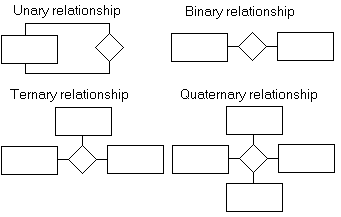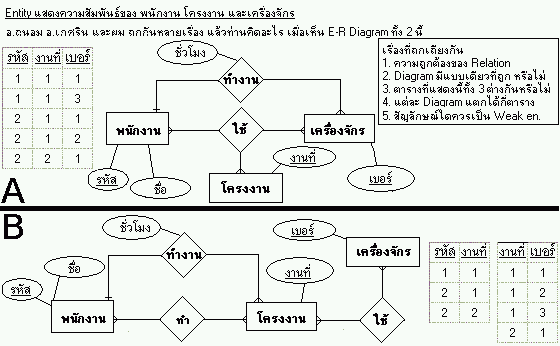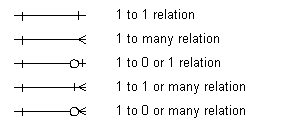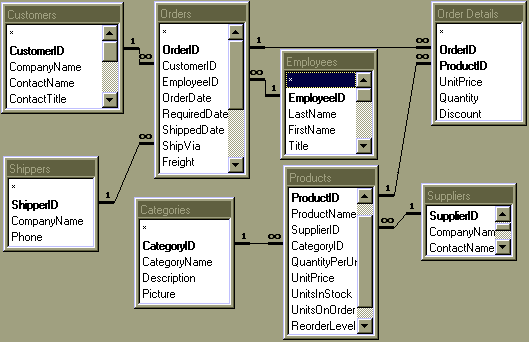join function is easy to use concate string from array.
example<php
$array = array('lastname', 'email', 'phone');
$comma_separated = join(",", $array);
echo $comma_separated; // lastname,email,phone
?>
(php4, php5);
Eclipse,Netbeans,Java,PHP,C/C++/C#,.NET,Visual Studio
#include < stdio.h>
#include < conio.h>
#include < math.h>
main()
{
int A,B,C=0,D;
printf("Program for finding Prime Number!\n\n\t you enter D=");
scanf("%d",&D);
printf("\nSo, prime number which is less than %d is...\n\n ",D);
printf("2\n");
for(A=3;A<=D;A+=2) { for(B=3;B<=sqrt(A);B+=2) {if(A%B==0) break;} if(B>sqrt(A))
{ printf("%d\n",A);
C+=1;
}
}
printf("\n\n\t***There are %d.\n\n\n\r",C+1);
getch();
}
| orderid 301 | orderdate 15/12/46 | productid 401 402 | quan 2 5 |
| 302 | 16/12/46 | 402 405 406 | 4 4 1 |
| saleid 101 | salesalary 2000 | saleposition sale | custid 201 202 203 204 | custname tom dang boy girl |
Invoice No.: A0001 |
การเริ่มต้นทำ normalization ต้องนำข้อมูลมาสร้าง ตารางเริ่มต้น ซึ่งเป็นขั้นตอนก่อนการทำ 1NF
โดยไม่เขียน amount และ total เพราะเป็นค่าที่เกิดจากการคำนวณเท่านั้น
ตาราง temp
A0001,24/10/2004,ABC company,Pen,50,3
A0001,24/10/2004,ABC company,Book,100,5
A0001,24/10/2004,ABC company,Ruler,20,2
A0002,24/10/2004,XYZ company,Pen,100,3
A0002,24/10/2004,XYZ company,Book,120,5
A0002,24/10/2004,XYZ company,Ruler,50,2
การทำ 1NF ของ ตัวอย่าง 5.3
นำตารางเริ่มต้นมาจัดการเรื่อง multivalue เช่น คนชอบกินหลายอย่าง หรือการเพิ่ม key ประกอบข้อมูลที่อาจซ้ำ
ตัวอย่างนี้เพิ่มรหัสลูกค้า และรหัสสินค้า เป็น key เพราะคิดว่า ชื่อลูกค้า และชื่อสินค้า อาจมีโอกาสซ้ำกันได้ และไม่เหมาะที่จะเป็น key
ตาราง tempoforder
A0001,24/10/2004,101,ABC company,201,Pen,50,3
A0001,24/10/2004,101,ABC company,202,Book,100,5
A0001,24/10/2004,101,ABC company,203,Ruler,20,2
A0002,24/10/2004,102,XYZ company,201,Pen,100,3
A0002,24/10/2004,102,XYZ company,202,Book,120,5
A0002,24/10/2004,102,XYZ company,203,Ruler,50,2
การทำ 2NF ของ ตัวอย่าง 5.3
แยกตาราง tempoforder เป็นหลายตาราง และทุกตารางมี primary key ที่มีการตรวจสอบการขึ้นตรงอย่างถูกต้อง
primay key คือ รหัสใบสั่งซื้อ
ตาราง invoid_1
A0001,24/10/2004,101,ABC company
A0002,24/10/2004,102,XYZ company
primay key คือ รหัสใบสั่งซื้อ และรหัสสินค้า
ตาราง invoid_2
A0001,201,50,3
A0001,202,100,5
A0001,203,20,2
A0002,201,100,3
A0002,202,120,5
A0002,203,50,2
ตาราง product เพราะราคาขึ้นกับรหัสสินค้า
primary key คือ รหัสสินค้า
ตาราง product
201,Pen,3
202,Book,5
203,Ruler,2
การทำ 3NF ของ ตัวอย่าง 5.3
ตาราง invoid_1 เพราะชื่อลูกค้าไม่ขึ้นกับรหัสใบสั่งซื้อ จึงต้องแยกไปทำตาราง customer
primay key คือ รหัสใบสั่งซื้อ
ตาราง invoid_1
A0001,24/10/2004,101
A0002,24/10/2004,102
ตาราง customer เพราะชื่อลูกค้าไม่ขึ้นกับ รหัสใบสั่งซื้อ แต่ขึ้นกับรหัสลูกค้า
primay key คือ รหัสลูกค้า
ตาราง customer
101,ABC company
102,XYZ company
primay key คือ รหัสใบสั่งซื้อ และรหัสสินค้า เพราะ ปริมาณ และราคาต้องขึ้นกับ key 2 ตัวนี้
ตาราง invoid_2
A0001,201,50,3
A0001,202,100,5
A0001,203,20,2
A0002,201,100,3
A0002,202,120,5
A0002,203,50,2
ตาราง product เพราะราคาขึ้นกับรหัสสินค้า
primary key คือ รหัสสินค้า
ตาราง product
201,Pen,3
202,Book,5
203,Ruler,2
|
| ||||||||||||||||||||||||||||







| << การตั้งค่าให้ดอสพร็อมพ์ในวินโดวส์ 2000/XP/2003 ให้ใช้ภาษาไทยได้ >> |
| เขียนโดย คุณ ทัชชี่ |
| โดยปกติแล้ว เราจะไม่สามารถใช้ภาษาไทยใน DOS BOX บนวินโดวส์ 2000 ขึ้นไป ไม่ได้เลย อ่านก็ไม่ได้ เขียนแล้วก็อ่านไม่รู้เรื่อง จะเปลี่ยนฟอนต์เป็นฟอนต์ที่มีภาษาไทยก็ไม่ได้อีก ดังนั้นมันต้องมีอะไรแน่ๆครับ ผมเคยไปอ่านเจอวิธีแก้ปัญหานี้ใน Technet ของ Microsoft แต่มันเป็นวิธีแก้ปัญหาของคนในประเทศอื่นๆที่ไม่ได้มีลักษณะภาษาแบบภาษาไทย (ที่มันต้องมีสระบนสระล่างนี่แหล่ะครับ) ซึ่งลักษณะการแก้ปัญหาก็คล้ายๆกัน ผมจึงได้ลองประยุกต์ใช้ดู ปกติเราจะเห็นดอสของวินโดวส์ 2000/XP หน้าตาเป็นแบบนี้  แล้วเราต้องการเปลี่ยนเป็นแบบนี้  ผมมี 2 ตัวเลือกให้คุณเลือก คือ 1) สำหรับมือใหม่ 2) สำหรับมือเก่า 1. มือใหม่อ่านที่นี่ครับ ส่วนมือเก่า ข้ามไปอ่านหัวข้อถัดไปได้เลยครับ 1.1 ก่อนอื่นไปดาวน์โหลดไฟล์นี้มาก่อนครับ http://www.thaikore.com/forum/index.php?act=attach&type=post&id=609 แล้วก็มาแตกไฟล์ (Unzip) จะเห็นได้ว่ามีไฟล์ทั้งหมด 4 ไฟล์ ตามภาพนะครับ  1.2 ให้ติดตั้งฟอนต์ Courier MonoThai ดังนี้ - คลิก Start >> Run แล้วพิมพ์ในช่องว่า fonts - คลิกที่ไฟล์ courmon.ttf แล้วลากมาใส่โฟลเดอร์ fonts 1.3 ดับเบิลคลิกไฟล์ Registry ทั้ง 3 ไฟล์ เพื่อ Import เข้าไปใน Registry ของระบบ 1.4 Restart เครื่อง 1 ครั้ง 1.5 คลิก Start >> Programs >> Accessories >> Command Prompt แล้วคลิกตามภาพนี้  1.6 จากในภาพ ผมแนะนำให้ตั้งค่าขนาดฟอนต์เป็นขนาด 18 – 20 นะครับ เพื่อความคมชัด 1.7 หลังจากนั้นก็ลองใช้ดูได้เลยครับ 2. สำหรับมือเก่าอ่านตรงนี้ครับ 2.1 ดาวน์โหลดไฟล์ในข้อ 1.1 มานะครับ แล้วติดตั้งฟอนต์ให้เรียบร้อย 2.2 สั่งรันโปรแกรม regedit.exe แล้วเข้าไปแก้ไขในส่วนต่างๆ ดังนี้ HKEY_LOCAL_MACHINE\SOFTWARE\Microsoft\Windows NT\CurrentVersion\Console\Nls ให้เพิ่มข้อมูลชนิด String ชื่อ "0000041e" HKEY_LOCAL_MACHINE\SOFTWARE\Microsoft\Windows NT\CurrentVersion\Console\TrueTypeFont ให้เพิ่มข้อมูลชนิด String ชื่อ "874" มีข้อมูลภายในคือ "Courier MonoThai" HKEY_LOCAL_MACHINE\SOFTWARE\Microsoft\Windows\CurrentVersion\MS-DOS Emulation\Font ให้เปลี่ยนข้อมูลชนิด String ที่ชื่อ "font" ให้เป็น "Courier MonoThai" HKEY_LOCAL_MACHINE\SYSTEM\CurrentControlSet\Control\Keyboard Layout\DosKeybCodes ให้เพิ่มข้อมูลชนิด String ชื่อต่อไปนี้ "0000041E" มีข้อมูลภายในเป็น "th" "0001041E" มีข้อมูลภายในเป็น "th" "0002041E" มีข้อมูลภายในเป็น "th" "0003041E" มีข้อมูลภายในเป็น "th" 2.3 สั่ง Restart เครื่อง 1 ครั้ง 2.4 เข้ามากำหนดค่าต่างๆตามรูป 1.5 ครับ 2.5 ทีนี้ก็จะสามารถใช้งานได้แล้วครับ |

////////////////////////////////// Lists(Numerical Arrays) /////////////////////////////////
/**
* A small function to remove an element from a list(numerical array)
* Arguments: $arr - The array that should be edited
* $value - The value that should be deleted.
* Returns : The edited array
*/
function array_remove($arr,$value) {
return array_values(array_diff($arr,array($value)));
}
////////////////////////////////// Associative Arrays //////////////////////////////////////
/**
* This function will remove all the specified keys from an array and return the final array.
* Arguments : The first argument is the array that should be edited
* The arguments after the first argument is a list of keys that must be removed.
* Example : array_remove_key($arr,"one","two","three");
* Return : The function will return an array after deleting the said keys
*/
function array_remove_key() {
$args = func_get_args();
$arr = $args[0];
$keys = array_slice($args,1);
foreach($arr as $k=>$v) {
if(in_array($k, $keys))
unset($arr[$k]);
}
return $arr;
}
/**
* This function will remove all the specified values from an array and return the final array.
* Arguments : The first argument is the array that should be edited
* The arguments after the first argument is a list of values that must be removed.
* Example : array_remove_value($arr,"one","two","three");
* Return : The function will return an array after deleting the said values
*/
function array_remove_value() {
$args = func_get_args();
$arr = $args[0];
$values = array_slice($args,1);
foreach($arr as $k=>$v) {
if(in_array($v, $values))
unset($arr[$k]);
}
return $arr;
}
SELECT email,
COUNT(email) AS NumOccurrences
FROM users
GROUP BY email
HAVING ( COUNT(email) > 1 )
//"ip.php" example- display user IP address on any page
Header("content-type: application/x-javascript");
$serverIP=$_SERVER['REMOTE_ADDR'];
echo "document.write(\"Your IP address is: " . $serverIP . "\")";
?>
CURL has support for proxies, including SSL. Below we refer to the code snippet in the first example, but modify it to use a proxy.
[php] // Initialize the CURL library
$cURL = curl_init();
// Set the URL to execute
curl_setopt($cURL, CURLOPT_URL, "http://www.google.com");
// Set options
curl_setopt($cURL, CURLOPT_HEADER, 1);
curl_setopt($cURL, CURLOPT_RETURNTRANSFER, 1);
curl_setopt($cCURL, CURLOPT_HTTPPROXYTUNNEL, 1);
curl_setopt($cCURL, CURLOPT_PROXY, "myproxy.com:1080");
curl_setopt($cCURL, CURLOPT_PROXYUSERPWD, "mysuername:mypassword");
// Execute, saving results in a variable
$strPage = curl_exec($cURL);
// Close CURL resource
curl_close($cURL);
// This will print out the HTML contents
echo($strPage);
?>[/php]
source : http://www.codeandcoffee.com
public class Try
{
public static void main(String[] args)
{
System.out.println(Integer.toHexString(4500));
System.out.println(Integer.parseInt(Integer.toString(1194), 16));
}
};
function removeVal(arr, valToRemove){
// Normalize to a string like !val!!val!!val!
var s = '!' + arr.join('!!') + '!';
// Remove targeted values with delimiters
s = s.replace(new RegExp('!' + valToRemove + '!', 'g'), '');
// Remove delimiter added to end in step 1
s = s.replace(/^!/, '');
// Remove delimiter added to start in step 1
s = s.replace(/!$/, '');
// Convert to array
return s.split('!!');
}
function test(){
var arr = [2,1,2,2,5,7,12,15,21,2]; // Check case with end vals
var s = arr.toString();
arr = removeVal(arr, 2)
alert(s + '\n' + arr.toString());
}
<html>
<body>
<script type="text/javascript">
var str="Hello world!";
document.write(str.search("world") + "
");
document.write(str.search("World") + "
");
document.write(str.search("woorld") + "
");
</script>
</body>
</html>
join function is easy to use concate string from array.
example$array = array('lastname', 'email', 'phone');
$comma_separated = join(",", $array);
echo $comma_separated; // lastname,email,phone
?>
(php4, php5);
| Framework | PHP4 | PHP5 | MVC | Multiple DB's | ORM | DB Objects | Templates | Caching | Validation | Ajax | Auth Module | Modules | EDP |
| Akelos | - | ||||||||||||
| ash.MVC | - | - | - | - | - | - | |||||||
| CakePHP | - | - | |||||||||||
| CodeIgniter | - | - | - | - | - | ||||||||
| DIY | - | - | - | - | - | - | |||||||
| eZ Components | - | - | - | - | - | - | - | ||||||
| Fusebox | - | - | - | - | - | - | |||||||
| PHP on TRAX | - | - | - | - | - | ||||||||
| PHPDevShell | - | - | - | - | - | - | - | - | |||||
| PhpOpenbiz | - | - | - | - | |||||||||
| Prado | - | ||||||||||||
| QPHP | - | - | |||||||||||
| Seagull | - | - | - | ||||||||||
| Symfony Project | - | - | - | ||||||||||
| WACT | - | - | - | - | - | ||||||||
| WASP | - | - | - | - | - | ||||||||
| Zend | - | - | - | - | |||||||||
| ZooP | - | - | - |